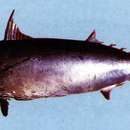Diseases and Parasites
provided by Fishbase
Hexostoma auxidi Disease. Parasitic infestations (protozoa, worms, etc.)
- Recorder
- Crispina B. Binohlan
Trophic Strategy
provided by Fishbase
Epipelagic in neritic and oceanic waters (Ref. 9340). Feeds on small fish, squids, planktonic crustaceans (megalops), and stomatopod larvae (Ref. 5213). Because of their abundance, they are considered an important element of the food web, particularly as forage for other species of commercial interest. Preyed upon by larger fishes, including other tunas (Ref. 9987). Confined to oceanic salinities with strong schooling behavior. Though larvae have a high temperature tolerance (at least between 21.6 and 30.5°C), the widest among tuna species studied, their optimum temperature is between 27 and 27.9°C.
Morphology
provided by Fishbase
Dorsal spines (total): 10 - 12; Dorsal soft rays (total): 10 - 13; Analspines: 0; Analsoft rays: 10 - 14
Migration
provided by Fishbase
Oceanodromous. Migrating within oceans typically between spawning and different feeding areas, as tunas do. Migrations should be cyclical and predictable and cover more than 100 km.
Life Cycle
provided by Fishbase
In correlation with temperature and other environmental changes, the spawning season varies with areas, but in some places it may even extend throughout the year.
Diseases and Parasites
provided by Fishbase
Bomolochus Disease. Parasitic infestations (protozoa, worms, etc.)
- Recorder
- Crispina B. Binohlan
Diseases and Parasites
provided by Fishbase
Callitetrarhynchus Disease. Parasitic infestations (protozoa, worms, etc.)
- Recorder
- Crispina B. Binohlan
Diseases and Parasites
provided by Fishbase
Phyllodistomum Disease. Parasitic infestations (protozoa, worms, etc.)
- Recorder
- Crispina B. Binohlan
Diseases and Parasites
provided by Fishbase
Colocynotrema Disease. Parasitic infestations (protozoa, worms, etc.)
- Recorder
- Crispina B. Binohlan
Diseases and Parasites
provided by Fishbase
Opepherotrema Infestation. Parasitic infestations (protozoa, worms, etc.)
- Recorder
- Crispina B. Binohlan
Diseases and Parasites
provided by Fishbase
Phacelotrema Disease. Parasitic infestations (protozoa, worms, etc.)
- Recorder
- Crispina B. Binohlan
Diseases and Parasites
provided by Fishbase
Didymozoon Disease. Parasitic infestations (protozoa, worms, etc.)
- Recorder
- Crispina B. Binohlan
Diseases and Parasites
provided by Fishbase
Tergestia Disease. Parasitic infestations (protozoa, worms, etc.)
- Recorder
- Crispina B. Binohlan
Diseases and Parasites
provided by Fishbase
Rhipidocotyle Infestation. Parasitic infestations (protozoa, worms, etc.)
- Recorder
- Crispina B. Binohlan
Diagnostic Description
provided by Fishbase
This species is distinguished by the following characters: a robust body, elongated and rounded; teeth small and conical, in a single series; total gill rakers on first gill arch 36-42; dorsal fins 2, D1 X-XII, separated from the second by a large interspace (at least equal to length of first dorsal-fin base), second dorsal fin followed by 8 finlets; anal fin followed by 7 finlets; pectoral fins short, but reaching past vertical line from anterior margin of scaleless area above corselet; a large single-pointed flap (interpelvic process) between pelvic fins; body naked except for the corselet, which is well developed and narrow in its posterior part (no more than 5 scales wide under second dorsal-fin origin); a strong central keel on each side of caudal-fin base between 2 smaller keels. Colour of back bluish, turning to deep purple or almost black on the head; a pattern of 15 or more narrow, oblique to nearly horizontal, dark wavy lines in scaleless area above lateral line; belly white; pectoral and pelvic fins purple, inner sides black (Ref 9684).
Biology
provided by Fishbase
Adults are epipelagic in neritic and oceanic waters (Ref. 9340). They feed on small fish, squids, planktonic crustaceans (megalops), and stomatopod larvae (Ref. 5213). Because of their abundance, they are considered an important element of the food web, particularly as forage for other species of commercial interest. They are preyed upon by larger fishes, including other tunas (Ref. 9987). Marketed fresh and frozen (Ref. 9340) and also utilized dried or salted, smoked and canned (Ref. 9987).
Importance
provided by Fishbase
fisheries: highly commercial; gamefish: yes; price category: very high; price reliability: reliable: based on ex-vessel price for this species

